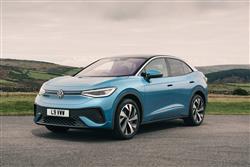Volkswagen ID.5 - ABC Leasing
FIVE START(some text hidden)
By Jonathan Crouch
Ten Second Review word count: 71
With the ID.5 mid-sized coupe-SUV, Volkswagen offers a more aspirational kind of mid-sized EV crossover. It certainly has a dash more pavement presence than the ID.4 SUV it's entirely based upon: and in top GTX hot hatch form, it better showcases the brand's more potent AWD dual motor powertrain. It's been considerably improved in this updated form; enough to now make it worth a second look? You might just think so.
Background word count: 134
The ID.5, introduced in 2022, was the third of Volkswagen's series of ID electric models, essentially a coupe version of the ID.4. By the time of this model's launch, we'd already seen two other VW Group brands announce coupe versions of their mid-sized EVs. So the Skoda Enyaq iV spawned the Enyaq iV Coupe and the Audi Q4 e-tron sired the Audi Q4 Sportback e-tron. But ID.5 sales were slow, not helped by somewhat unremarkable driving range figures, lack-lustre performance and a less-than-user-friendly interior media interface. So Volkswagen rushed forward the package of update changes which brought us the improved model we look at here, announced at the end of 2023. The range figures are better, power outputs have risen dramatically and the interior's easier to get on with. Let's take a closer look.
Driving Experience word count: 443
The ID.5 powertrain range starts with a base 52kWh model that uses a Pure 170PS rear-mounted motor and goes up to 226 miles between charges. Ideally though, Volkswagen wants you to choose a bigger-battery 77kWh version with their latest APP550 motor which generates 286PS. This puts out a massive 75% more torque than a base 77kWh ID.5 model did at its original launch back in 2022 (up from 310 to 545Nm, with power up from 174PS); things have really moved on. Despite all this extra pulling power, Volkswagen's managed to make the APP550 upgraded motor more efficient too: mainstream 77kWh ID.5 variants are now supposed to make it up to 339 miles between charges (11.8 miles further than before). Or you can stretch to the top sporty ID.5 GTX, which as before adds an extra motor on the front axle (creating nominal AWD) but now puts out 340PS (41PS more than before), enough to get you to 62mph in 5.4s. Range is up to 327 miles. The ID.5 GTX gets a special downforce package, consisting of a larger spoiler and diffuser, to aid high speed stability. And the chassis has been tuned to handle the extra performance, plus there's lowered suspension and upgraded brakes. And customers can order the brand's 'DCC' adaptive damping system too. The steering is Volkswagen's 'Progressive' set-up (where the ratio becomes more direct as the wheel is turned). Whatever variant you choose, the whole ID.5 experience should be familiar if you've tried one previously. If you haven't, there's a bit to adapt to if this is your first experience of EV motoring. No gearstick, no handbrake, no ignition key and just the sound of silence as the fixed ratio transmission blends an almost endless wave of torque into meaningful and surprisingly rapid forward progress. Like Volkswagen's original post-war Beetle, base versions of this car are rear-driven and when you drive such an ID.5 in town, you quickly realise the real advantages of placing the powertrain - the electric motor and its associated single-speed auto gearbox - on the back axle, thereby freeing up the front wheels for steering duties; the result is a London taxi-like 10.2-metre turning circle. Beyond the city limits, that drive format allows for a near-50:50 almost perfect weight distribution which, together with the low centre of gravity provided by the central battery pack placement, helps disguise the portly weight this SUV must carry around. Traction through the turns is excellent and body roll is checked by firm damping cleverly engineered for suppleness over poor surfaces. All of which ought to provide the recipe for a decently sporting EV - and in some ways it does.
Pictures (High res disabled)


.jpg)
.jpg)
.jpg)
.jpg)
.jpg)
.jpg)
.jpg)

Scoring
Category: Compact Car
| Performance | |
| Handling | |
| Comfort | |
| Space | |
| Styling | |
| Build | |
| Value | |
| Equipment | |
| Economy | 80% |
| Depreciation | 70% |
| Insurance | 70% |
| Total | 72% |